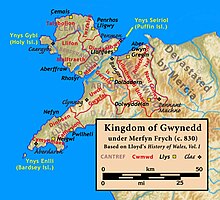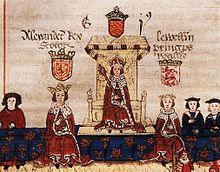House of Aberffraw
| House of Aberffraw | |
|---|---|
King of the Welsh | |
| Connected families | |
| Deposition | 1283 |
The House of Aberffraw was a
The Royal House is deemed to be a
Aberffraw hundred (cantref)
The name of the royal house derives from

Latin: CATAMANUS REX SAPIENTIS MUS OPINATISM US OMNIUM REG UM.
English: King Cadfan, the Wisest and Most Renowned of All Kings.[10]
Welsh dynasties
In the 9th century, Rhodri the Great (
Succession
Royal succession within the House of Aberffraw (as with succession in Wales in general) was a complex matter due to the unique character of Welsh law.[14] According to Hubert Lewis, though not explicitly codified as such, the edling, or heir apparent, was by convention, custom, and practice the eldest son of the lord or Prince and was entitled to inherit the position and title as "head of the family" from the father. This was effectively primogeniture with local variations. However, all sons were provided for out of the lands of the father, and in certain circumstances so too were daughters (with children born both in and out of wedlock considered legitimate).[14] Men could also claim royal title through the maternal patrimony of their mother's line in certain circumstances (which occurred several times during the period of Welsh independence).[15] The female line of the dynasty was also considered to remain royal, as marriage was an important means of strengthening individual claims to the various kingdoms of Wales and uniting various royal families to that of Aberffraw, or reuniting factions after dynastic civil wars (for example with the marriage of Hywel Dda, a member of the Dinefwr branch of the Aberffraw dynasty, and Elen of Dyfed, daughter of Llywarch ap Hyfaidd, King of Dyfed).[16] This meant that the female line was considered as a legitimate path of royal descent within the House of Aberffraw, with the claims of royal women to titles usually transferring to their sons.[citation needed]
Cambro-Norse era

During the Cambro-Norse era (850s – 1100s), Wales was subjected to Viking raids all throughout the country between 852 and 919 (the Jómsvíkinga saga refers to that period). An example of this pattern was with the Viking leader Ingimund who was expelled from Dublin and tried unsuccessfully to establish a base on Anglesey (c. 902), but instead left for Chester.[17]
The Welsh Kingdoms had been subject to the Kingdom of Mercia from the 7th century onwards. This led to the construction of Offa's Dyke, a territorial land border between England and Wales built in the mid to late 8th century. However, war broke out against the English for decades from 853, this culminated in a victory for The Welsh Kingdoms of Gwynedd and Powys against the English Mercian and Wessex Kingdoms who had been assisted by Anglo-Saxons and Danes (Vikings).[12][18][19]
After successful battles for
The second phase of
Power base (Norman invasion)
The family were able to assert their influence within Gwynedd, their traditional sphere of influence, but by the 11th century they were ousted from
Aberffraw senior line
Below is a partial family tree of the dynasty of Gwynedd.[29]
- Gruffudd ap Cynan (c. 1055–1137), Prince of Gwynedd
- Owain Gwynedd (c. 1100 – 28 November 1170), Prince of the Welsh, Prince of Gwynedd = Cristina ferch Gronw ap Owain ap Edwin
- Hywel ab Owain Gwynedd Prince of Gwynedd 1170 [d]
- Caswallon ap Hywel [e]
- Iorwerth ab Owain (1145–1174),
- Llywelyn ab Iorwerth (c. 1173 – 11 April 1240), de facto Prince of Wales, Prince of Gwynedd and Powys, Prince of Aberffraw and Lord of Snowdon. [f]
- Rhodri ab Owain Gwynedd (c. 1146–1195), Lord of Anglesey = Annest ferch Rhys ap Gruffudd
- Hywel ab Owain Gwynedd Prince of Gwynedd 1170 [d]
- Owain Gwynedd (c. 1100 – 28 November 1170), Prince of the Welsh, Prince of Gwynedd = Cristina ferch Gronw ap Owain ap Edwin
Princes of Wales (de facto)
The Kingdoms of Wales defended their territory from
Llywelyn the Great
By 1203 Llywelyn ap Iorwerth (Llywelyn I, the Great) had followed in the footsteps of his grandfather, Owain Gwynedd, and unified the divided Kingdom of Gwynedd. He further advanced to conquer all of Wales by 1207.
13th century

During the 13th century, Wales was ruled by
Footnotes
- ^ The palace (or llys) at Aberffraw was originally thought to have been located to the west of the village but recent research suggests it was likely located within the boundaries of the village itself.[5]
- ^ Owain's Welsh position was further reaffirmed in the biography The History of Gruffydd ap Cynan. Written in Latin, the biography was intended for an audience outside Wales.[28]
- ^ The significance of this claim was that the Aberffraw family owed nothing to the English king for their position in Wales, and that they held authority in Wales "by absolute right through descent", wrote historian John Davies.[27]
- ^ eldest surviving son after the death of Rhun ab Owain, succeeding as his father's chosen heir. Died 1170 in battle at Pentreath, against his brother Dafydd. The Chronicle of the Princes (Brut y Tywysogyon) records the following entry in the year 1170: One thousand one hundred and seventy was the year of Christ when Dafydd ab Owain slew Hywel ab Owain (Red Book of Hergest Version translated and arranged by Thomas Jones, 1955). See in genealogical tables in J.E. Lloyd's History of Wales: The Line of Gwynedd.
- ^ [see: PC Bartrum Welsh Genealogies AD 300–1400 (1974), page ref: Gruffudd ap Cynan 10]. Caswallon has proven direct male ancestors who exist into the modern day and thereby represent the senior surviving male line of Owain Gwynedd – the genealogy of one family was recorded by Peter Gwynn-Jones, late Garter King of Arms, at The College of Arms.
- ^ The last of the Llywelyn line died out with the death of Owain Lawgoch in 1378
References
- ISBN 978-0140284751., Chapter 4
- ^ Davies 1994, pp. 116, 128, 135, 136.
- ^ Lewis 1889, pp. 192–200.
- ISBN 978-0140284751.
- ^ "Aberffraw Palace, Aberffraw (15012)". Coflein. RCAHMW. Retrieved 15 September 2023.
- ^ a b "Aberffraw (32986)". Coflein. RCAHMW. Retrieved 15 September 2023.
- ^ "Aberffraw, Excavated Features, Rejected Roman Fort and Suggested Llys Site (401126)". Coflein. RCAHMW.
- ISBN 978-0-7083-1953-6
- Tout, Thomas Frederick (1885–1900). . Dictionary of National Biography. London: Smith, Elder & Co. p. 190.
- ^ "St Cadwaladr". nationalchurchestrust.org. Retrieved 28 August 2023.
- ^ Pierce, Thomas Jones (1959). "Rhodri Mawr ('the Great') (died 877), king of Gwynedd, Powys, and Deheubarth". Dictionary of Welsh Biography. National Library of Wales.
- ^ a b c Lloyd, John Edward (1896). . In Lee, Sidney (ed.). Dictionary of National Biography. Vol. 48. London: Smith, Elder & Co. p. 85.
- ^ "MERFYN FRYCH (died 844), king of Gwynedd". Dictionary of Welsh Biography. National Library of Wales.
- ^ a b Davies 1994, p. ?.
- ^ Lloyd 2004, p. 220.
- ^ Koch 2006, p. 945.
- ^ ISBN 9781134318261. Retrieved 28 August 2023.
- ISBN 978-0-19-821731-2.
- ^ "Offa's Dyke: built by multiple kings?". Current Archaeology. XXV, No. 3 (291): 6. June 2014.
- ISBN 978-0140284751.
- ISBN 0-85115-598-7.
- ^ Carradoc of Lhancarvan (1697). The History of Wales. Translated by David Powel and. Augmented by W. Wynne. p. 38.
- ^ Stephen, Leslie; Lee, Sidney, eds. (1890). . Dictionary of National Biography. Vol. 23. London: Smith, Elder & Co. pp. 301–304.
- ^ Lloyd 2004.
- ISSN 0036-9241.
- ISBN 978-0140284751.
- ^ a b Davies 1994, p. ??.
- ^ Jones, Arthur (1910). The history of Gruffydd ap Cynan. Manchester University Press.
- ^ Turvey 2010, p. 13.
- ^ Turvey 2010, pp. 7, 10–11.
- ISBN 978-0140284751.
- ^ a b "LLYWELYN ap IORWERTH (or 'Llywelyn the Great', often styled 'Llywelyn I', though in strictness the first prince of that name was Llywelyn ap Seisyll; 1173-1240, prince of Gwynedd". Dictionary of Welsh Biography. National Library of Wales.
- ^ a b . Dictionary of National Biography. London: Smith, Elder & Co. 1885–1900.
- ^ Davies 1994, p. 137–139.
- ^ a b Pierce, Thomas Jones (1959). "Llywelyn ap Gruffydd ('Llywelyn the Last,' or Llywelyn II), Prince of Wales (died 1282)". Dictionary of Welsh Biography. National Library of Wales.
- ^ a b Pierce, Thomas Jones (1959). "Dafydd ap Gruffydd (David III, died 1283), prince of Gwynedd". Dictionary of Welsh Biography. National Library of Wales.
- ^ Tout, Thomas Frederick (1888). . In Stephen, Leslie (ed.). Dictionary of National Biography. Vol. 14. London: Smith, Elder & Co. pp. 202–205.
- ^ Pierce, Thomas Jones (1959). "Owain ap Thomas ap Rhodri (' Owain Lawgoch '; died 1378), a soldier of fortune and pretender to the principality of Wales". Dictionary of Welsh Biography. National Library of Wales.
Sources
- Davies, John (2007). A History of Wales (Revised ed.). Penguin. ISBN 978-0140284751.
- Davies, John (1994). A History of Wales. London: OCLC 650493756.
- Koch, Thomas (2006). Celtic Culture: a Historical Encyclopaedia. Santa Barbara, US: ABC-CLIO. ISBN 9781851094400.
- Lewis, Hubert (1889). "VIII". The Ancient Laws of Wales. London: Elliot Stock. OCLC 1304160411.
- Lloyd, J.E. (2004). A History of Wales; From the Norman Invasion to the Edwardian Conquest. New York, US: Barnes & Noble Publishing. ISBN 9780760752418.
- Turvey, Roger (2010). Twenty-One Welsh Princes. Conwy: ISBN 9781845272692.
Further reading
- Chisholm, Hugh, ed. (1911). . Encyclopædia Britannica. Vol. 2 (11th ed.). Cambridge University Press.
- Morris-Jones, John (1911). . In Chisholm, Hugh (ed.). Encyclopædia Britannica. Vol. 28 (11th ed.). Cambridge University Press.

